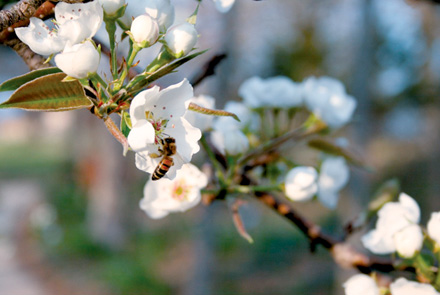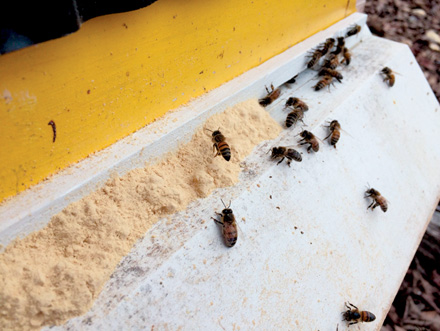Love in the Garden

Bees really should replace Valentine’s Day cherubs. Bees are among a number of pollinators that provide nature’s match-making services, and they are much less obtrusive than those little pink, round winged love-match makers.
Without bees to spread pollen, many plants, including food crops, would die off. One out of every three bites of food we eat is pollinated by bees.
Although they perform their match-making differently, both honeybees and native bees significantly contribute to keeping many plant species alive. If you have good habitat, which means a variety of flowers succeeding each other with blooms, you will also have a good place for both native and honeybees to live.
When a bee visits a flower, it is focused on gathering nectar and pollen to feed the colony back in the hive.
Bumblebees, also significant crop pollinators, have a specific name for their matchmaking. It’s called “buzz pollination,” or sonication. As they hold on to a flower, bumblebees rapidly vibrate flight muscles without moving their wings. This vibration shakes electrostatically charged pollen out of the flower anthers and the pollen is attracted to the bumblebee’s oppositely charged body hairs. For bumblebees, electricity really is “in the air.”
The bumblebee later grooms the pollen from her body into bags on its legs and takes it back to the nest in the ground.
Bumblebees pollinate tomatoes, green peppers and a variety of other specialty crops. Some commercial producers have either bumblebee hives in their greenhouses or leave a 1-inch opening at the bottom of their covered growing areas so bumblebees can more easily access plants.
Bumblebee hives are available for purchase but the colony lives only one year. At the end of the season, only the queen bee survives in the ground to start a new colony the following year.
Honeybees pollinate by concentrating on one plant species at a time. Honeybees have compound eyes so they see the world as a series of small windows, which would make the world even more complex than it already is to me. For a honeybee to more easily see a flower, it is best to plant flowers in large groups or swaths so a bee can better first spot them.
I spray sugar water syrup on plants when I want to attract the attention of a bee. Honeybees navigate more by scent so the sugar is a good calling card.
As honeybees move from one flower to the next, pollen falls out of their body hairs and gets moved among flowers.
Honeybees have pouches on the side of their legs. Once the leg pollen bags are full, honeybees return to the hive, sometimes so heavily laden they literally crash land at the hive entrance.
It’s interesting to watch them coming home at the end of the day. I try to guess what flowers they were visiting based on the color of the flower pollen they are carrying.
This time of year, nothing is blooming except for spring dreams.
Charlotte Ekker Wiggins is a beekeeper, gardener and sometimes cook. Published by El Dorado Springs Sun once in print and online with author’s permission. Copyright 2017, all rights reserved. This column may not be reprinted, republished or otherwise distributed without author’s permission. Contact Charlotte at gardeningcharlotte at gmail dot com.
 BUSY BEE – One of my honeybees in spring moves pollen among the flowers in my compact pear tree. The pollination ensured the tree will bear fruit later in the year.
BUSY BEE – One of my honeybees in spring moves pollen among the flowers in my compact pear tree. The pollination ensured the tree will bear fruit later in the year.

BUSY WORK – Since winter days have been warmer than usual this year, I feed my honeybees a pollen substitute so they have something to take back to the hive for food. (Photos by Charlotte Ekker Wiggins).



Facebook Comments